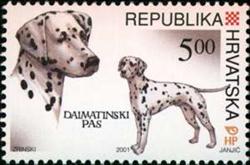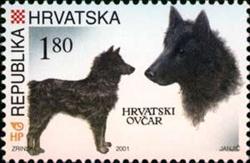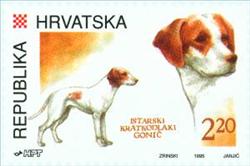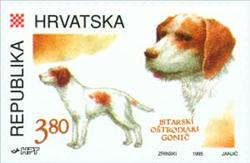Dalmatian dog is a well known breed from Dalmatia - the coastal part of Croatia. It is white, with black or liver-colored spots, very clean, alert and curious, and can be taught as watchdog and hunter.
We know about organized breeding of this dog in the Djakovo bishopric already in the 14th century! The name was given in the USA in the 19th century, previously also known as the Dubrovnik hunter. Recognized as Croatian autochthonous breed in 1994 (FCI-153).

Dalmatian dog, issued by Croatian Post
HRVATSKE AUTOHTONE PASMINE PASA
Marku oslika Ratko Janjić, Zagreb
Marke su izdane u arcima od 20 maraka, a izdana je i prigodna omotnica prvog dana (FDC). Vrijednost: 5,00 Kn
DALMATINSKI PAS
Još su starim Egipćanima bili poznati bijeli psi posuti malim tamnim mrljama i pravilnim pjegama. Na slikarijama iz kasnog srednjeg vijeka također možemo naći pse slično obojena krzna. Bili su rasprostranjeni diljem Europe baš zbog svoje neobične pigmentacije ali jednako tako i zbog svoje osebujne naravi.
Prvi opis i crtež dalmatinskoga psa kakvoga poznajemo u naše doba objavio je 1792. Englez Thomas Bewick. Možda je upravo on najzaslužniji što tu pasminu danas čitav svijet smatra hrvatskom. Između niza naziva koji su i u njegovo doba korišteni za tu pasminu odbrao je upravo onaj koji trajno i nedvojbeno označava njezino zemljopisno podrijetlo.
Danas su dalmatinski psi jedna od najpopularnijih pasmina svijeta. Nazivaju se hrvatskom autohtonom pasminom, iako je kroz stoljeća doživjela razne uzgojne utjecaje. Osnovna obilježja pasmine su ravnomjerno posute crne i li smeđe okrugle pjege na kratkoj bijeloj dlaci, građa zajednička psima koji pripadaju skupini goniča, te snažno a pri tome skladno zaobljeno i vrlo elegantno tijelo.
Višestoljetni i svijetom rasprostranjeni uzgoj zbog estetskih svojstava dalmatinske je pse udaljio od njihove davno zaboravljene lovačke uporabe. Danas u pravilu služe kao izložbeni psi i kućni ljubimci. Zbog takvog su uzgojnog cilja nasljedne tjelesne osobine pasmine dovedene do visokog estetskog sklada. Taj prilično jednostran i uzak selekcijski pristup ipak nije uništio osebujne psihičke karakteristike dalmatinskih pasa.
U pravilu su bistre, prilagodljive i poučljive prirode. Mnogi postižu dobre rezultate kao radni ili sportski školovani psi. Zbog osebujna izgleda, žive naravi i spremnosti na učenje srećemo ih kao maskote američkih vatrogasaca koji ih nazivaju psima sv. Florijana, a ponekad i kao četveronožne cirkuske artiste. Zanimljiva je upadna sklonost tih pasa prema konjima. Neki smatraju da je ona posljedica običaja koji je vladao u ranom razdoblju postojanja pasmine - dalmatinskih pasa kao pratilaca jahača, konja i kočija.
Suvremena gojidba pasmine u Hrvatskoj je relativno mlada. Iako je ponovo utemeljena tek početkom sedamdesetih, činjenica da je 1994. godine Međunarodna kinološka federacija i administrativno priznala domicilnost pasmine u Hrvatskoj, a potom 1999. g. dalmatinske pse konačno stavila pod punu nadležnost Hrvatskog kinološkog saveza, daje jak poticaj nizu naših stručnjaka za čistokrvne pse. Posljednjih godina neki među njima uključili su se ravnopravno u svjetska uzgajačka kretanja. S rezultatima svoga uzgoja postižu vrlo zapažene međunarodne uspjehe i u najjačoj svjetskoj konkurenciji.
Osebujnost, svjetska popularnost dalmatinskih pasa a pogotovo njihovo podrijetlo s naše južne morske obale naprosto vape za većom brojnošću dalmatinskih pasa u Dalmaciji i za kreativnim korištenjem te pasmine u hrvatskoj promidžbi.
Izvor: Hrvatska pošta
|
CROATIAN INDIGENOUS BREEDS OF DOGS
Stamp painted by Ratko Janjić, Zagreb
The stamps have been issued in 20-stamp sheets, and the Croatian Post has also issued the commemorative First Day Cover (FDC). Value: 5.00 Kn
DALMATIAN DOG
Even ancient Egyptians have known these white dogs covered with small black specks and regularly shaped spots. On paintings originating from the late Middle Ages we can also find dogs with similarly coloured fur. They were spread all over Europe on account of their unusual pigmentation but also because of their distinctive disposition.
The first description and drawing of a Dalmatian dog that we have encountered in our times was published in 1792 by the Englishman Thomas Bewick. Much credit goes to him for this breed to be considered Croatian by the whole world. Among the many names used for this breed during his lifetime, he has chosen the one that has continuously and undoubtedly marked its geographical origin.
Nowadays Dalmatian dogs are one of the most popular breeds of dogs in the world. Many people call them the Croatian indigenous breed though through centuries they have undergone different breeding influences. The basic features of the breed are the regularly spread black or brown round specks on the short white hairs, their built is similar to the group of pointers, and they have a strong though harmoniously rounded and very elegant body.
Spread all over the world through many centuries, the raising of the breed targeted at the esthetic features has caused the Dalmatian dogs to be removed from their old, long forgotten usage as hunting dogs. As a rule, nowadays they serve either as exhibition dogs or pet dogs. With this target in raising, the hereditary body features of the breed have been brought to a high esthetic harmony. This rather one-sided and limited selective attitude has still been unable to destroy the decisive psychological characteristics of Dalmatian dogs.
In principle, they are of a clever, adaptable disposition, ready and willing to be taught. Many of them achieve good results when trained for work or sports. On account of their exterior, lively nature and readiness to learn, we can encounter them as mascots of the American firemen who call them St.Florian's dogs. They can often be found among the animals performing in circuses, too. These dogs show a remarkable devotion to horses. Some people think that this is the consequence of customs from the early stage of existence of the breed - when Dalmatian sheep-dogs have been employed as escorts of riders, horses and coaches.
The contemporary dog breeding in Croatia is relatively recent. Though reintroduced at the beginning of the 70s, it is a fact that in 1994 the International Kennel Club Federation has administratively acknowledged Croatia as the domicile of the breed, and then, in 1999 Dalmatian dogs have finally been put under the full authority of the Croatian Kennel Club Union. This has given great stimulus to a number of our experts for thoroughbred dogs and their breeders. In recent years some of them have joined the world breeding trends on an equal footing. They have achieved excellent international success in a tough world competition with the results of their breeding.
The distinctive world popularity of Dalmatian dogs, and particularly their origin from the southern sea coast, clearly show the demand for a greater number of Dalmatian dogs in Dalmatia and for a more creative exploitation of this breed in the promotion of Croatia.
Source: Croatian Post
|

Croatian sheep-dog, issued by Croatian Post

Istrian short-haired hunting dog, issued by Croatian Post

Istrian wire-haired hunting dog, issued by Croatian Post

Posavina hunting dog, issued by Croatian Post
Croatian breeds: Dalmatian dog (FCI-153), the Croatian shepherd (FCI-277), Istrian short hair hound (FCI-151b), Istrian coarse-haired (FCI-152b), Posavina hound (FCI-154), Croatian mountain dog Tornjak (see also here).
Formated for CROWN by prof.dr. Darko Žubrinić
Distributed by www.Croatia.org . This message is intended for Croatian Associations/Institutions and their Friends in Croatia and in the World. The opinions/articles expressed on this list do not reflect personal opinions of the moderator. If the reader of this message is not the intended recipient, please delete or destroy all copies of this communication and please, let us know!